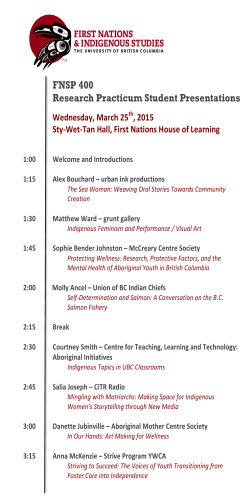
4 Step & Myths Poster - Indigenous Eye Health Unit
9 Myths About Trachoma MYTH # 1 “Trachoma does not blind Indigenous Australians.” Trachoma causes 9% of blindness in Indigenous Australian adults. In Central Australia 5% of people over 40 years have corneal scarring from trachoma. The rates are comparable to the worst affected communities in Africa. (NIEHS) MYTH # 2 “Trachoma isn’t an important problem.” 163 communities in Australia still need trachoma intervention, 33% exceed WHO active trachoma thresholds (5%) and 8% are still hyper endemic (>20%). Trichiasis rates are 10 times the WHO threshold (0.1%). (NTSRU) MYTH # 3 “Other infections are more important than Trachoma.” Trachoma and other programs work together to keep children and families healthy and strong. Combining hygiene messages and antibiotics will reduce both trachoma and other infections. MYTH # 4 “Its normal for kids to have dirty faces.” Children can easily get their faces dirty while playing, but always having eye and nose secretions on their faces is neither normal nor healthy. Infected eye and nose secretions transmit trachoma. Every dirty face is a health hazard. MYTH # 5 “Old people usually have sore eyes and poor vision.” It is not normal for older people to have sore eyes or poor vision. Clinics must check for trichiasis (in-turned lashes) before treating sore eyes and refer them if further treatment is needed. Melbourne School of THE UNIVERSITY OF MELBOURNE Population & Global Health MYTH # 6 “Trachoma elimination is not possible in Indigenous communities because people move around.” This is a logistic challenge, however trachoma elimination programs are synchronized and delivered regionally to reach those who travel. Most transmission occurs within the household and visitors only provide a secondary source of infection. MYTH # 7 “Trachoma and chlamydia are the same.” The bacterial strain of Chlamydia trachomatis causing trachoma differs from the genital strain. Chlamydial STI is caused by closely sharing infected genital secretions. Trachoma is caused by closely sharing infected eye secretions. MYTH # 8 “Trachoma will not be eliminated until Aboriginal housing is improved.” Poor housing, poor plumbing and taps that don’t work are important risk factors for a number of diseases including trachoma. However, the elimination of trachoma does not need to wait until all Indigenous housing is improved. If faces are disappear. kept clean, trachoma will MYTH # 9 “Trachoma elimination is impossible because the workforce changes frequently.” The workforce in remote health services is transient and so ongoing training for clinical staff is required. NIEHS - National Indigenous Eye Health Survey: Minum Barreng (Tracking Eyes): Indigenous Eye Health Unit, School of Population and Health, University of Melbourne, 2008. ISBN: 9780734041142. NTSRU - Australian Trachoma Surveillance Report 2013. National Trachoma Surveillance and Reporting Unit, The Kirby Institute, University of New South Wales. For online training resources and other material www.iehu.unimelb.edu.au
© Copyright 2025









